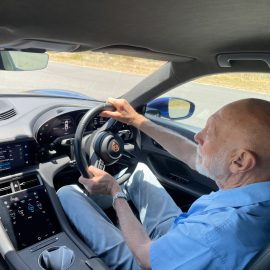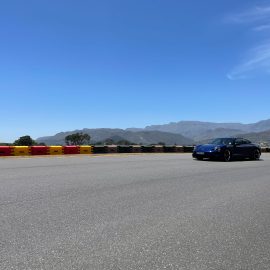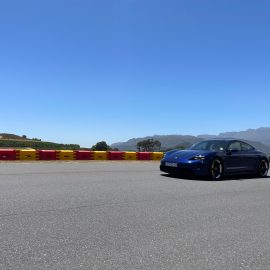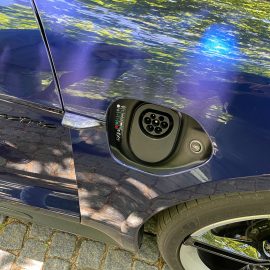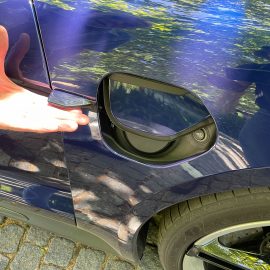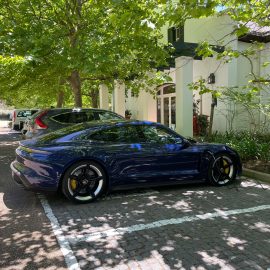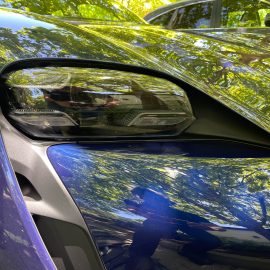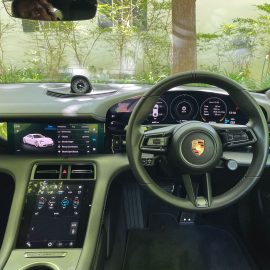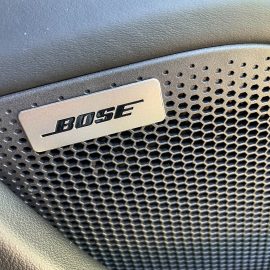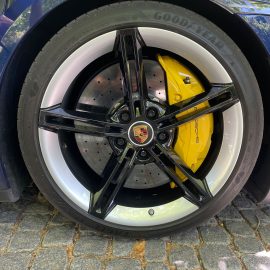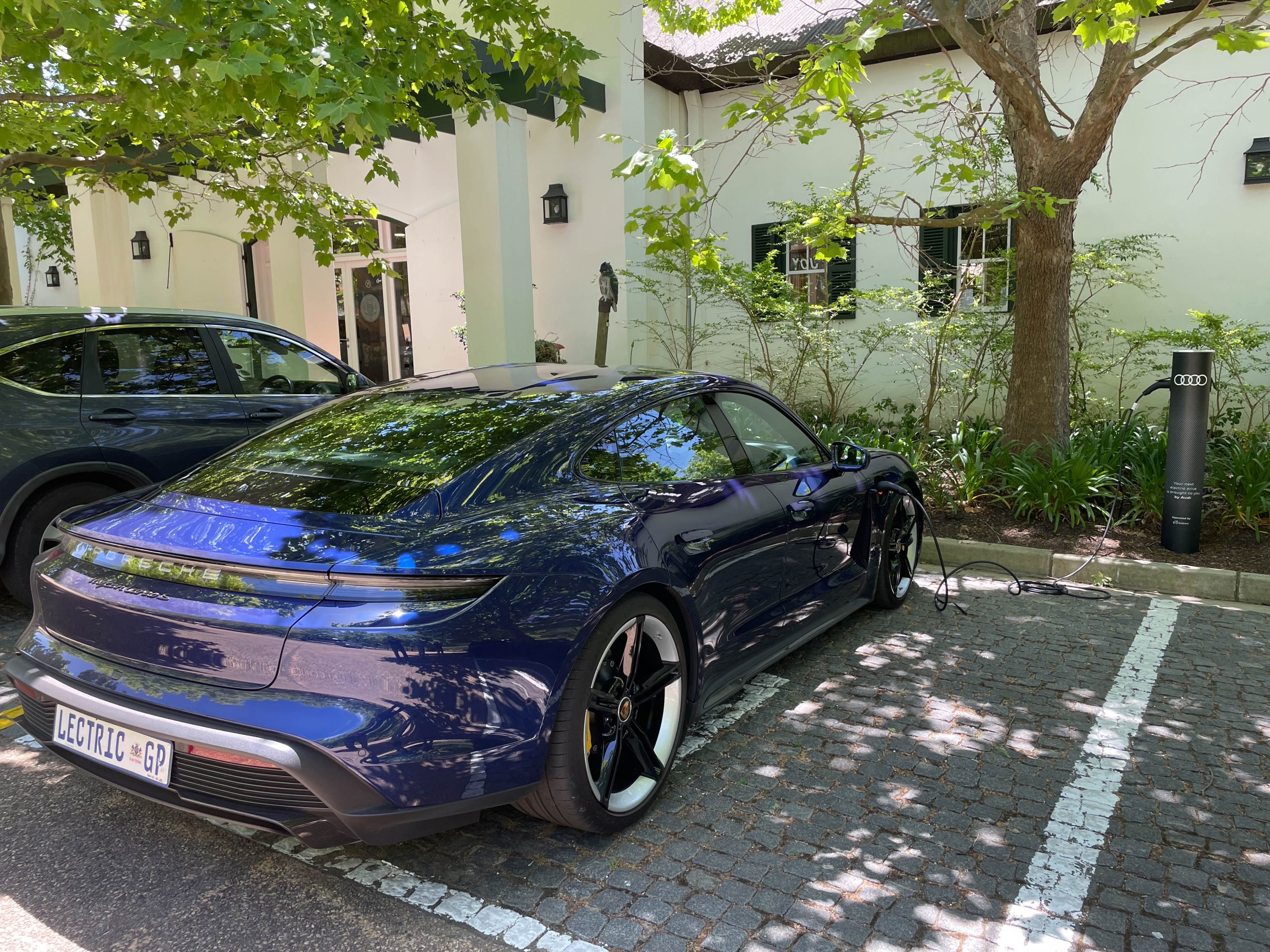
30 Jan Back To The Future with the Porsche Taycan
Museums are defined as “a building or institution where objects of artistic, historical, or scientific importance and value are kept, studied, and put on display”. FMM is no exception, but also keeps up with the times. FMM recently spent time with a Porsche Taycan Turbo S…
The Taycan is Porsche’s first ground-up all-electric powered model and, as to be expected, it is jam-packed with innovative technology. The press pack for this model reads like a science non-fiction novel and to try and include everything in this brief report is simply not practical. However, following are the introductions to the various aspects of the car that, hopefully, will give the reader some idea of what the car is all about. Driving impressions appear at the end. Prepare for lift-off…
The exterior design: Pure new design with Porsche DNA
Breaking new ground in the best Porsche design tradition – that was the brief for designing the Taycan. As it was designed as a fully electric vehicle from the outset, new freedoms opened up for the designers. At the same time, the first purely electrically powered Porsche had to be immediately recognisable as such. The result is an emotionally charged, four-door sports saloon that carries the unmistakeable Porsche design DNA. Its silhouette is defined by the sporty roofline sloping downward to the rear – called a ‘flyline’ by the Porsche designers. The highly sculpted side sections are also characteristic. The sleek cabin (the greenhouse), the drawn-in C-pillar and the pronounced shoulders of the wings result in a sharply emphasised rear, typical of the brand. At the same time, with its clean, pure approach and innovative elements such as the Porsche lettering in glass-effect in the rear light bar, the sports saloon signals that, at first glance, a new era has begun. However, the Taycan has remained very close to the 2015 Mission E concept car on the whole.
The body: Intelligent mix of materials for maximum strength
The strut mounts, axle mounts and the rear side members are made of die-cast aluminium. The shock absorber mounts are forged aluminium. The front side members combine an aluminium shell construction with extruded sections. The 1,941-millimetre sills are designed as seven-chamber extruded sections. Compared to steel sills, this reduces the number of components per side from 15 to three and the weight by around 3.4 kilograms. Hot-formed steels protect the passenger compartment (A-pillar structure, B-pillar inside/outside, side roof frame, seat cross member).
The chassis: Committed to driving dynamics
From uncompromisingly sporty to comfortable: the chassis of the new Taycan offers a broad spectrum, with the choice between the precise handling of a sports car and the long-distance comfort of a saloon. The basic layout: at the front, Porsche uses a double-wishbone axle with forged aluminium wishbones and hollow-cast aluminium
lightweight swivel bearings. On the rear axle, a multi-link axle with forged upper aluminium wishbones and hollow-cast lower aluminium wishbones performs wheel guidance.
The interior design: Digital, simple, sustainable
The original 911’s cleanly styled dashboard from 1963 was the inspiration. The stated goal was to bring it into the present day. The cockpit signals the start of a new era with its clear structure and a completely new construction. It is clearly driver-focused. The instrument panel has a clean, minimalist and ultra-modern design, and operating the controls is quick and free from distractions. The free-standing, curved instrument cluster forms the highest point on the dashboard. It is clearly focused towards the driver and ensures that everything that is needed for driving is in view.
The innovative instrument cluster consists of a curved 16,8-inch screen with the rounded look that is typical of Porsche. A cowl has been committed, which ensures a slim and modern appearance in the style of high-quality smartphones and tablets. Drivers can choose between four display modes for the instrument cluster: The mode Power meter evokes the rounded instruments typical of Porsche. This display delivers information that is clearly arranged information, allowing for fast readability. A power meter replaces the rev counter in the middle instrument. The Map mode replaces the central power meter with a map layout. The Full Map mode intentionally omits the round instruments in favour of a navigation map displayed across the full display. The view ‘reduced’ is limited to the essential driving information such as speed, road signs and navigation instructions using a minimised arrow. There are also small, touch-control fields at the edges of the screen for operating the light and chassis functions. The instrument cluster is therefore wider than the steering wheel and reminiscent of the original 911.
The battery: Sophisticated thermal management, 800-volt system voltage
The Performance Battery Plus is located in the underbody of the Taycan, ensuring a low centre of gravity and thus sporty driving characteristics. The battery housing is a load-bearing component of the body structure, accommodating cooling and electronic components and protecting them from environmental influences. The Taycan is the first production vehicle with a system voltage of 800 volts instead of the usual 400 volts for electric cars. This enables consistent high performance, reduces the charging time and decreases the weight and installation space of the cabling. The two-tier Performance Battery Plus used in the Taycan Turbo S and Taycan Turbo contains 33 cell modules consisting of 12 individual cells each (396 in total). The total capacity is 93,4 kWh.
The charging process: Quick, comfortable, intelligent and universal
In addition to exciting cars, a customer-friendly charging infrastructure is the key to the lasting success of electric mobility. Taycan drivers can comfortably charge their vehicles with up to 11 kW of alternating current (AC) at home. On the road, they benefit from the vehicle’s 800-volt technology and the ingenious temperature control strategy for the battery. The Performance Battery Plus allows the vehicle to be charged with higher currents (direct current, DC), thus speeding up the process significantly: in just over five minutes, the battery can be recharged for a range of up to 100 kilometres (according to WLTP). The charging time for five to 80 percent SoC (state of charge) is 22,5 minutes in ideal conditions at 800-volt high-power charging stations, with a maximum charging capacity (peak) of 270 kW.
The powertrain: Pure performance
Breathtaking acceleration figures, typical sports car traction and superior, continuously available power output. These are the aspects that have to be fulfilled if you want to talk about a true sports car. The new Taycan meets these requirements. This makes it unique in its segment. The top Turbo S version of the Taycan can generate up to 560 kW overboost power in combination with Launch Control, and the Taycan Turbo up to 500 kW) . The Taycan Turbo S accelerates from 0-100 km/h in 2.8 seconds, and the Taycan Turbo in 3,2 seconds. The top model reaches the 200 km/h mark in 9,8 seconds, while the Turbo takes 10,6 seconds. The range of the Turbo S is up to 412 kilometres, and up to 450 km for the Turbo (according to WLTP). The top speed of both all-wheel-drive models is 260 km/h.
The Porsche sound: A special acoustic experience
The sound of a Porsche is its acoustic calling card. Every fan knows the unmistakeable sound of a six-cylinder Porsche boxer engine. Powertrain sounds not only create an emotional connection with one’s car but they are also an important early warning system for traction conditions, for example. Electric cars also have their own sound. The Porsche Electric Sport Sound in the Taycan Turbo S (optional for the Taycan Turbo) is skilfully composed and tailored to the vehicle’s personality and vehicle status. What is more, all Taycan models also have a standard system to meet the legal requirements for pedestrian protection. This is harmoniously adapted to the Electric Sport Sound. The Porsche Electric Sport Sound makes the vehicle’s own drive sound even more emotionally charged and richer with its innovative character both on the outside and inside. For this purpose, disturbing noises from the drive architecture are deliberately minimised and harmonious, emotive sounds matching what the car is doing are amplified. These are composed in such a way that a sound experience typical of Porsche is created: with a clear electrical statement but unquestionably the sound of a genuine Porsche.
Wayne’s view:
I know it sounds like sacrilege coming from a petrolhead like myself, but these electric sports cars are just absolutely phenomenal the way they accelerate, thanks to the amount of torque they possess and how much of it is available right from the word go. Yes, the car feels heavy – you can’t dispute that fact – but this Taycan goes around a corner like a cat on a carpet with its claws out! Yet when you drive to town it’s just the perfect luxury sedan. However, I found the accident early warning feature very disconcerting, and which almost gave me a heart attack when I was just trying to cross an intersection. The Taycan is very wide for a standard parking bay and it is not the easiest car to park in a busy street. Overall though, I can comfortably live with this new automotive future. I’m just not sure how we are going to recharge EVs if Eskom keeps up with load shedding!
Mike’s comment:
Just walking around the car I got an immediate impression of Power and Presence. It’s unmistakably a Porsche and the Turbo S badging suggests another P – Performance. Once inside and on the move, this Powerhouse lives up to all expectations. The Taycan is a big car and when driving along, its bulk is always evident. In the short drive I had it was impossible to evaluate the abundance of technical innovations this car possesses, so it was simply a case of indulging in the overall experience. And what an experience it was. Sure, its mass is all too evident when braking and pushing hard through corners, but the response to input from the right foot is, er, electric (sorry!), that contributes to a feeling of invincibility. Never mind the profusion of gadgetry, hit the road and watch the sparks fly…!





